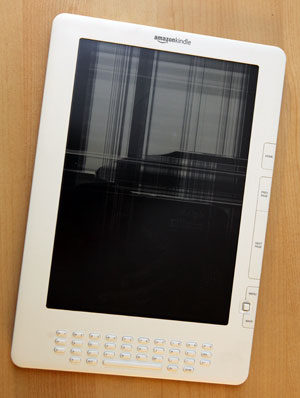 This time of year travel is anything but rare and chances are good that at some point a delay will have you sitting in an airport with nothing to do. The obvious solution is to bring your Kindle along for the ride. Reading is always a pleasant way to kill time, of course. The problem comes in deciding whether or not this is safe to do.
This time of year travel is anything but rare and chances are good that at some point a delay will have you sitting in an airport with nothing to do. The obvious solution is to bring your Kindle along for the ride. Reading is always a pleasant way to kill time, of course. The problem comes in deciding whether or not this is safe to do.
There have been numerous reports of airport security causing Kindle screen failure in the past and it continues to be an issue. Amazon denies that the usual sort of security scanners employed in airports have any chance of harming their eReaders. Even leaving aside my own personal anecdotes involving extensive holiday travel having failed to do anything to a Kindle, they’re obviously correct. The radiation being used in these scanners is simply far too weak to manage to do any real harm to E INK displays, even over the course of repeated scane.
Where it gets tricky is in the associated mechanisms. Naturally, to speed up the processing, belts are employed to feed baggage through scanners. We’ve all seen or used them from time to time. These long rubber belts, constantly in motion, have the potential to build up a significant charge. Some estimates have indicated it could easily reach or exceed 100 volts. In instances where this discharges through a Kindle, of course it is going to freeze the E INK permanently in place. Of course, that sort of thing isn’t particularly good for just about any piece of electronics.
While it seems unlikely that this phenomenon alone is sufficient to account for all of the reports of travel damage, keep in mind that it is travel damage. Tight bags, rough handling, and not infrequent jostling in crowds and tightly packed planes inevitably takes its toll. Given that the Kindle line makes use of display technology that is notoriously brittle, it is to be expected to some extent.
In order to ensure safety for your favorite Kindle, especially the eReader models since the Kindle Fire has proven extremely resilient, there are a few things you can do. The simplest is packing carefully. Make sure that your Kindle is in a good protective case or at least not in a position to be supporting any weight or accepting any major pressure. This won’t be particularly helpful if you are one of the rare cases of airport scanner damage, but for general hits it makes all the difference.
If you are particularly concerned about the scanner, keep in mind that the damage likely to be the result of static discharge. They make cheap protective products for help with that. Many people employ antistatic bags to protect data storage devices in transit and they should work just as well for the Kindle.
The overwhelming majority of the time, you have nothing to be worried about. What people remember are the rare exceptions and that tends to make for some rumors being blown out of proportion. Fortunately, even if you should end up with problems all reports indicate that Amazon has an unofficial policy of replacing airport-damaged eReaders. Enjoy your travel, bring your Kindle, and good luck with your travel this holiday season.
Just want to give my personal expirince since i work at a airport and my kindle gets scanned every working day for a year now
Kindle keyboard survived 7 months of daily xray without any harm to the display (no rubbery band transportage though)
My new Kindle 4 nt has its first scanning month with rughly 20 scans over now and also working without any harm.
As said in the post though thats just the XRAY part, no luggage rubber bands and stuff.
the real scanning is 100% safe in my opinion
Thanks for the confirmation, Foneb. Always nice to have as much input as possible.
every airport I’ve gone through has had the electronics in plastic bins, not directly on the belts.
besides, 100v of static electricity isn’t that much, you will generate far more than that on your person when you notice a shock (that will frequently get up in the thousands of volts)
I’ve had a kindle every since the kindle 2 came out and I’ve had one time the screen acted up like that, it was a couple of weeks after a trip, but the trip was by car, and I had no problems getting Amazon to replace the device.
I suspect that the reason more people report problems with the kindles is simply that there are more of them out there.
My screen looks just like the one in the picture in this article.
While there doesn’t seem to be much agreement about the relationship between airport x-ray and kindle screens seizing up, the screening process was indeed when my kindle screen seized up. My kindle passed through screening in the outermost pocket of a suitcase. The suitcase was not in a plastic bin. I’m fairly certain the suitcase / kindle was facing up and not down so the problem would not have been caused by impact.